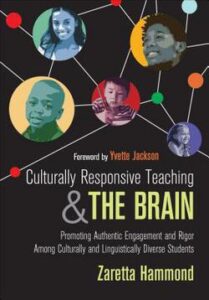
Culturally Responsive Teaching and The Mind: Advertising Reliable Engagement and Rigor Among the Culturally and Linguistically Diverse Learners
By Zaretta Hammond
(Corwin, 2015 – Understand more)
Reviewed by Monthly bill Ivey
 Culturally Responsive Educating and the Brain has turn out to be a single of the much better recognised go-to texts for instructors fascinated in carrying their equity work even further and inspecting the mentality necessary to put that operate to follow in the classroom. And deservedly so.
Culturally Responsive Educating and the Brain has turn out to be a single of the much better recognised go-to texts for instructors fascinated in carrying their equity work even further and inspecting the mentality necessary to put that operate to follow in the classroom. And deservedly so.
 Previous summertime I was a person of the facilitators of NENTS 2., a 4-day summertime workshop for early occupation lecturers supplied by the Connecticut Association of Independent Educational institutions and the Association of Impartial Schools of New England, and we demanded the text as advance studying for all our individuals.
Previous summertime I was a person of the facilitators of NENTS 2., a 4-day summertime workshop for early occupation lecturers supplied by the Connecticut Association of Independent Educational institutions and the Association of Impartial Schools of New England, and we demanded the text as advance studying for all our individuals.
We value Zaretta Hammond’s blend of a very clear clarification of mind-based mostly learning from a cultural perspective and a distinct description of how it appears to be in motion. When we in NENTS 2. get the job done with early profession lecturers, I discovered the e book on initially examine to also be useful to me as a late-mid vocation instructor, and I think it can be helpful to lecturers of all ages and experiences.
The book’s framework
1. Introduction
2. Making Consciousness and Expertise
a. Climbing Out of the Gap
b. What is Lifestyle Obtained to Do with It?
c. This Is Your Mind on Lifestyle
d. Planning to Be a Culturally Responsive Practitioner
3. Building Studying Partnerships a-c
a. Constructing the Foundation of Understanding Partnerships
b. Developing Alliance in the Discovering Partnership
c. Shifting Educational Way of thinking in the Learning Partnership
4. Creating Intellective Capability
a. Information and facts Processing to Make Intellective Capability
b. Making a Culturally Responsive Community for Understanding
5. Epilogue
6. Glossary
7. References and More Reading through
8. Index
Each and every chapter finishes with three bulleted lists: a chapter summary, an invitation to inquiry, and resources to go deeper.
Awareness, Discovering Partnerships, Information and facts Processing, and Community
The initially chapter introduces Zaretta Hammond’s Completely ready for Rigor framework: Consciousness, Discovering Partnerships, Information and facts Processing, and Community of Learners and Studying Setting (pp.17-20). In detailing the framework, Hammond can make the pursuing crucial details (amid others!):
- In creating consciousness, we require to understand how the brain learns, know and individual our individual cultural lenses, and know and have an understanding of the 3 stages of tradition.
- We have to have to rethink college student and instructor interactions as a partnership, encouraging just about every student build a perception of self-efficacy.
- We want to combine oral traditions with other techniques of facts processing, and give learners with authentic alternatives to course of action articles.
- And we want to assure pupils truly feel risk-free and have voice and agency. (Hammond, p.17)
By means of the guide Hammond develops each individual of these factors in bigger detail, which include a comprehensive description of the mind and how it capabilities. At the conclude of Chapter 1, we are invited to reflect on how our colleges are addressing the wants of small-doing college students of color, how we individually support pupils in getting independent learners, and how we and our colleagues can ‘operationalize’ the rules of culturally responsive educating (Hammond, p.20).
I found every of these reflection details to be valuable not just as a personalized check out on what my requires and these of my faculty definitely are, but also as a way of shifting a large amount of her info into for a longer period phrase storage.
Wanting into Individualistic and Collectivist Cultures
I also observed notably useful – equally for myself and for the early career instructors with whom I was operating – the data on individualism and collectivism in chapter 2 (pp.25-28), and the area on “Becoming a Warm Demander” in Chapter 6 (pp.97-99).
Inspecting additional deeply the attributes of individualistic cultures (these types of as the United States) and collectivist cultures (these kinds of as South Korea) assisted me to understand far more carefully the roots of a lot of of the cultural distinctions I see in my college, and further than.
Wanting at the chart of qualities of instructors who might be categorised as heat demanders, technocrats, sentimentalists, and elitists assisted me face up to features of my instructing persona that may well, however unintentionally, undermine my efficiency and believe about what actions I could just take.
Neuroscience and Lifestyle
Just about every chapter in this reserve is valuable – packed with information and facts about neuroscience and what a truly culturally responsive tactic appears like and why it is so successful. Culturally Responsive Educating and the Mind incites academics of all ages to reflect on how finest we can assistance our college students. No ponder it is so often suggested.
Invoice Ivey (he/any) is Center University Dean and teaches Humanities 7, Rock Band, and Educational Competencies at Stoneleigh-Burnham School, a gender inclusive ladies college for grades 7-12 in Western Massachusetts. He also serves on the NELMS Board of the Administrators as an advisor for fairness, inclusion, and social justice, and on the AMLE Fairness in Center Grades Education and learning Committee. See Bill’s other MiddleWeb testimonials and article content below.







